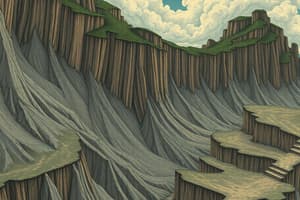Podcast
Questions and Answers
What is mass wasting primarily influenced by?
What is mass wasting primarily influenced by?
- Gravity and shear strength (correct)
- Wind and erosion
- Water and vegetation
- Temperature and pressure
Which factor does NOT contribute to mass wasting?
Which factor does NOT contribute to mass wasting?
- Soil nutrient content (correct)
- Weathering and climate
- Slope angle
- Vegetation removal
Which type of mass movement involves movement along a curved surface?
Which type of mass movement involves movement along a curved surface?
- Rock slide
- Creep
- Mudflow
- Slump (correct)
What distinguishing feature do mudflows have compared to debris flows?
What distinguishing feature do mudflows have compared to debris flows?
Creep is characterized by which of the following?
Creep is characterized by which of the following?
What best describes a flow that is more viscous and moves slowly downslope?
What best describes a flow that is more viscous and moves slowly downslope?
Which of these types of mass wasting is most common in areas with permafrost?
Which of these types of mass wasting is most common in areas with permafrost?
Complex movements in mass wasting generally involve which aspect?
Complex movements in mass wasting generally involve which aspect?
What primarily determines the occurrence of mass wasting events?
What primarily determines the occurrence of mass wasting events?
Which type of mass movement is characterized by the free-fall of rocks?
Which type of mass movement is characterized by the free-fall of rocks?
What is a feature of earthflows compared to mudflows?
What is a feature of earthflows compared to mudflows?
Which of the following factors is NOT typically associated with mass wasting?
Which of the following factors is NOT typically associated with mass wasting?
In terms of speed of movement, which type of mass wasting is the slowest?
In terms of speed of movement, which type of mass wasting is the slowest?
What contributes to complex movements in mass wasting?
What contributes to complex movements in mass wasting?
What distinguishes quick clays from other clay types?
What distinguishes quick clays from other clay types?
What type of slide involves movement along a curved surface?
What type of slide involves movement along a curved surface?
Flashcards are hidden until you start studying
Study Notes
Mass Wasting
- Downslope movement of material due to gravity
- Can result in loss of life and property damage
- Occurs when gravitational force exceeds the slope's shear strength
Factors Contributing to Mass Wasting
- Slope angle: Steeper slopes are more prone to mass wasting.
- Weathering and climate: Weathering weakens materials, making them more susceptible to movement. Climate influences weathering processes.
- Water content: Water can act as a lubricant, reducing friction and increasing the likelihood of movement. It can also add weight to the slope.
- Overloading: Adding weight to a slope, such as through construction or accumulation of debris, can trigger mass wasting.
- Removal of vegetation: Vegetation provides stability to slopes by anchoring soil and absorbing water. Removing vegetation increases the risk of mass wasting.
Classification of Mass Movements
- Rate of movement: Rapid vs. slow
- Type of movement: Falling, sliding, or flowing
- Type of material: Rock, soil, or debris
Types of Mass Movements
- Rockfalls: Free-fall of rocks, common in steep canyons and cliffs.
- Slides:
- Slumps: Rotational slides along a curved surface, common in unconsolidated material.
- Rock slides: Movement on a more or less planar surface, involving solid rock.
- Flows:
- Mudflows: Mostly clay and silt, containing up to 30% water. Common in arid and semi-arid environments.
- Debris flows: Larger particles than mudflows with less water.
- Earthflows: Slow, viscous movement of wet regolith.
- Quick clays: Liquefy spontaneously when disturbed, flowing like water.
- Solifluction: Slow movement of water-saturated material, common in areas with permafrost.
- Creep: Slow, imperceptible movement of soil or rock. Most widespread type of mass wasting.
Complex Movements
- Combinations of different types of mass movements.
- Often involve sliding and flowing.
Mass Wasting
- Definition: Downslope movement of material under the influence of gravity.
- Causes:
- Slope Angle: Steeper slopes are more susceptible to mass wasting.
- Weathering and Climate: Weathering weakens materials, making them more prone to failure. Climate influences water content and vegetation.
- Water Content: Excess water reduces friction between particles, leading to instability.
- Overloading: Adding weight to a slope can exceed its capacity.
- Removal of Vegetation: Roots help bind soil and prevent erosion.
- Classification:
- Rate of Movement: Rapid (e.g., rockfalls, landslides) or Slow (e.g., creep, solifluction)
- Type of Movement: Falling, Sliding, or Flowing
- Type of Material: Rock, Soil, or Debris
- Examples:
- Rockfalls: Freefall of rock, common in steep cliffs, canyons, and road cuts.
- Slides:
- Slumps: Rotational slides along a curved surface, common in unconsolidated material.
- Rock Slides: Movement along a planar surface, involving solid rock.
- Flows:
- Mudflows: Fast-moving flows with high water content (up to 30%), common in arid and semiarid environments.
- Debris Flows: Slower than mudflows, with larger particles and less water content.
- Earthflows: Thick, viscous flows of wet regolith.
- Quick Clays: Clay that liquefies and flows upon disturbance.
- Solifluction: Slow movement of water-saturated material, common in permafrost areas.
- Creep: Imperceptible downslope movement, the slowest type of mass wasting.
- Complex Movements: Combinations of different types, often involving sliding and flowing.
Studying That Suits You
Use AI to generate personalized quizzes and flashcards to suit your learning preferences.




